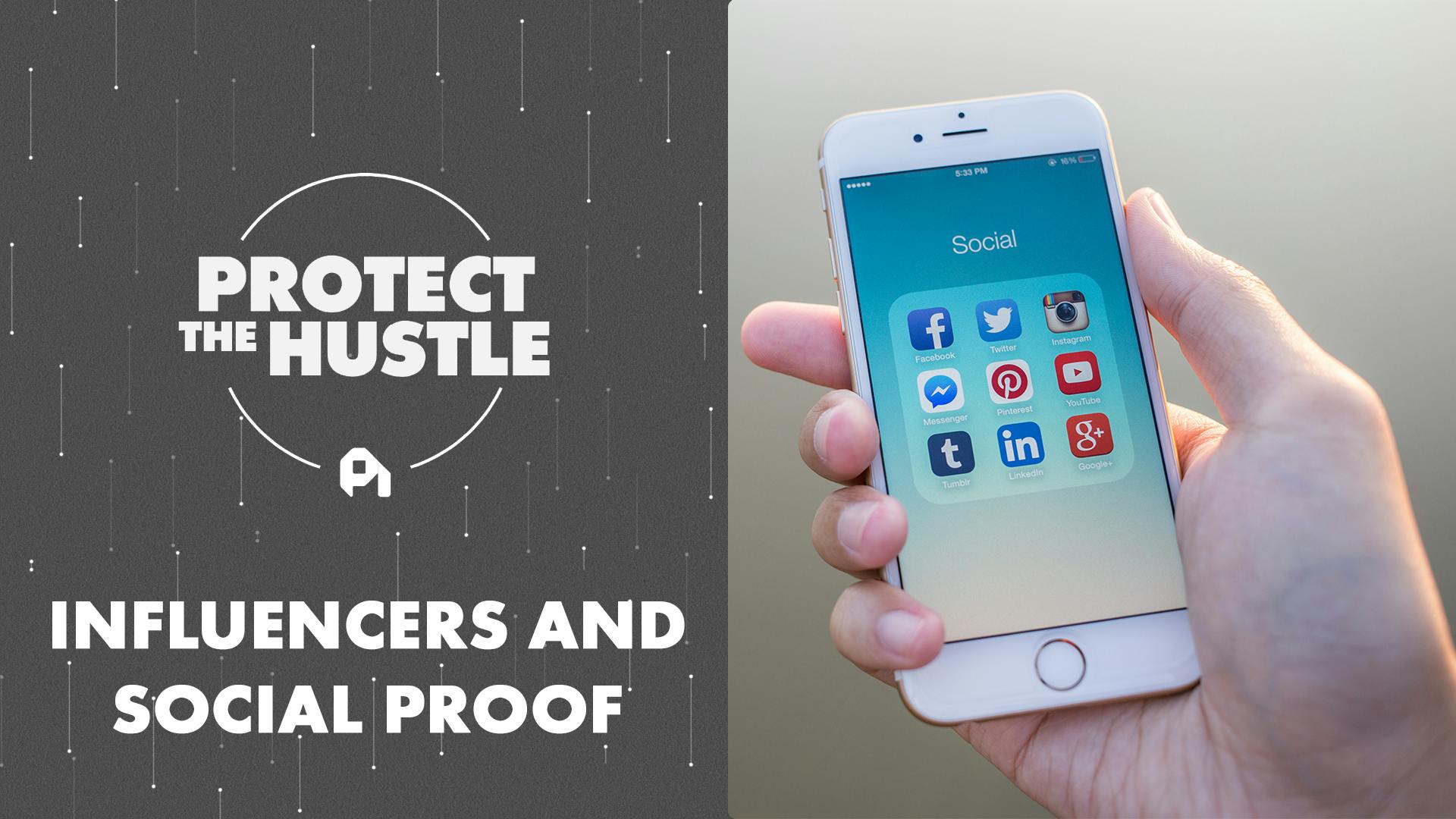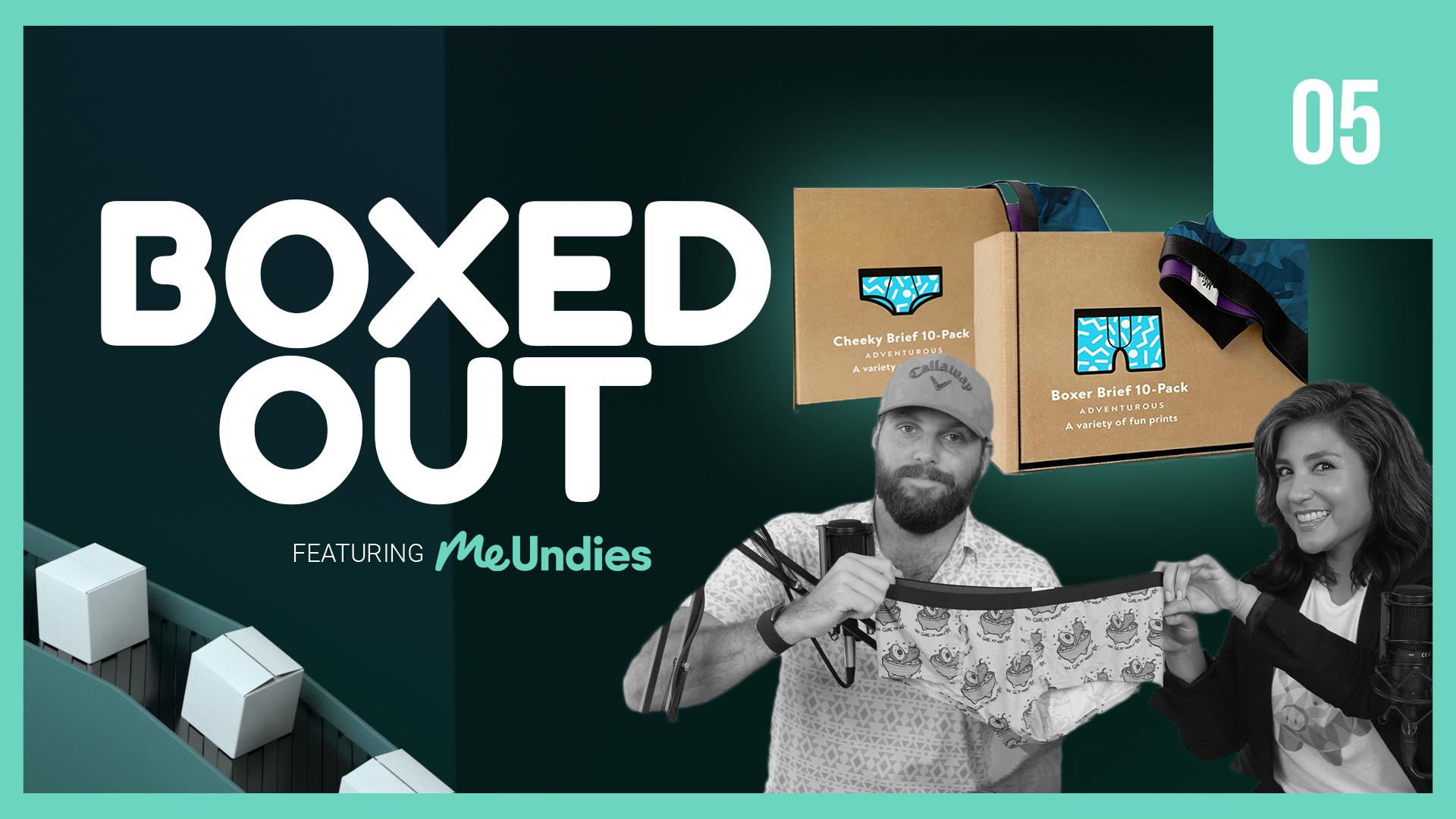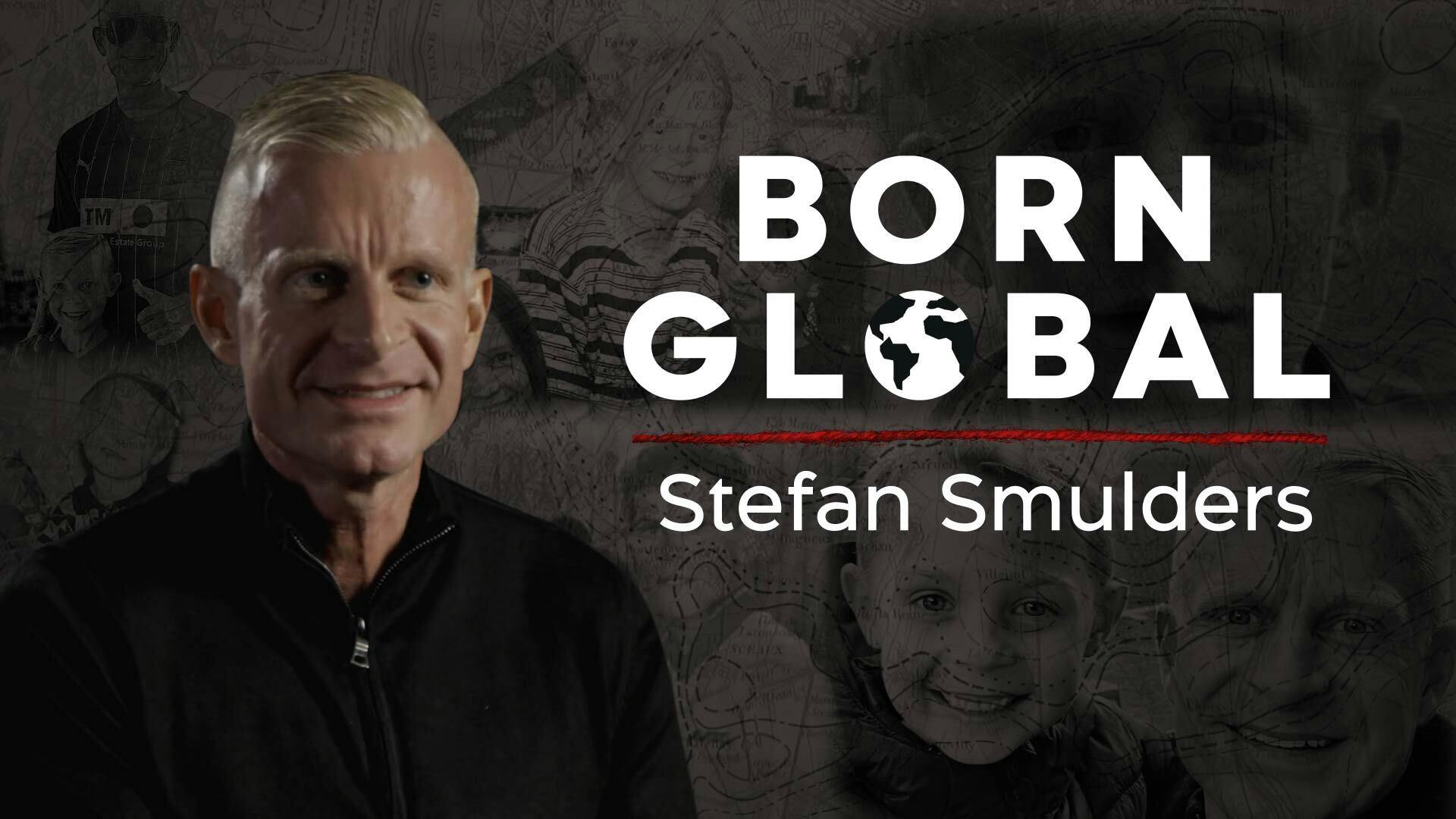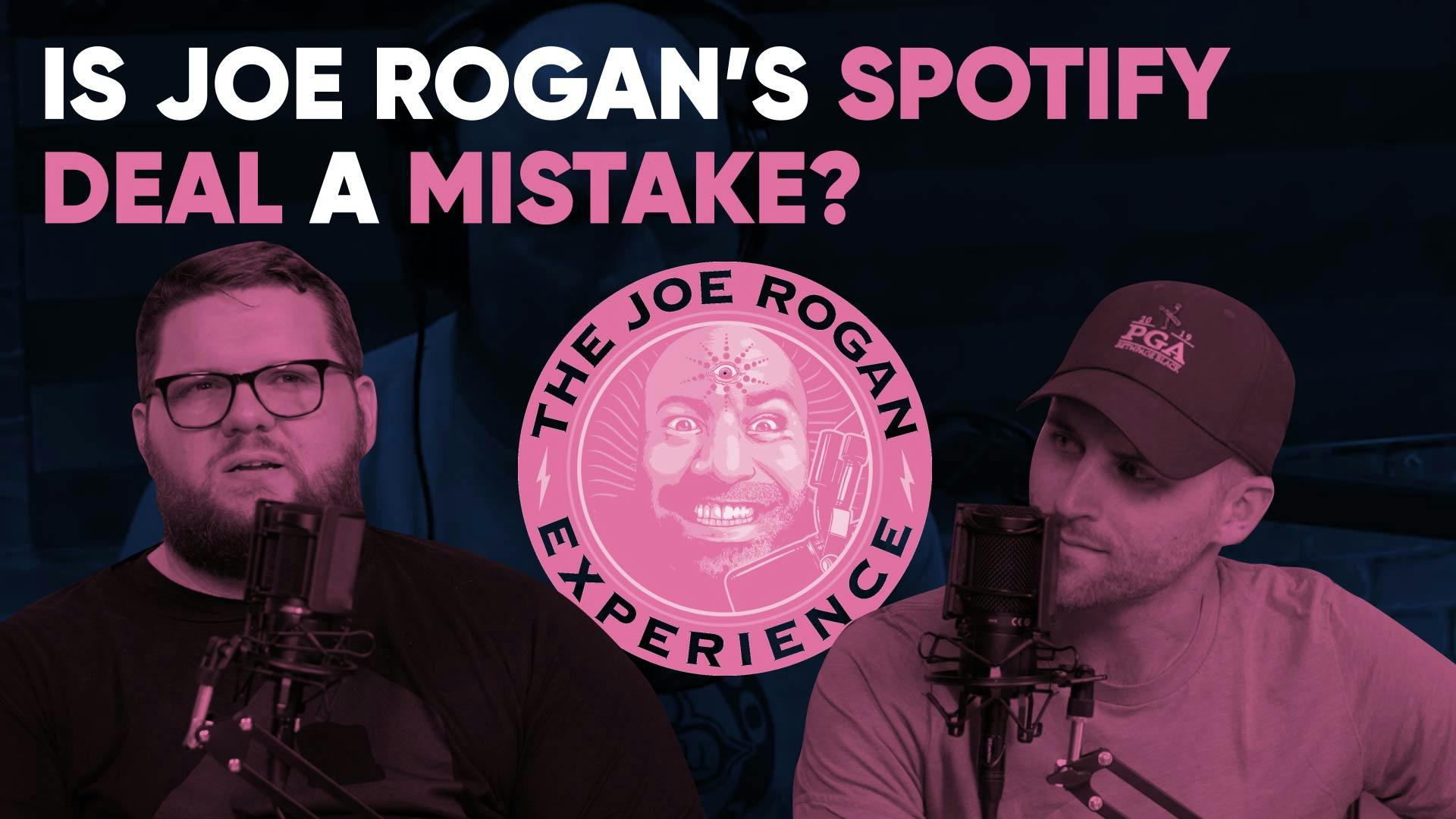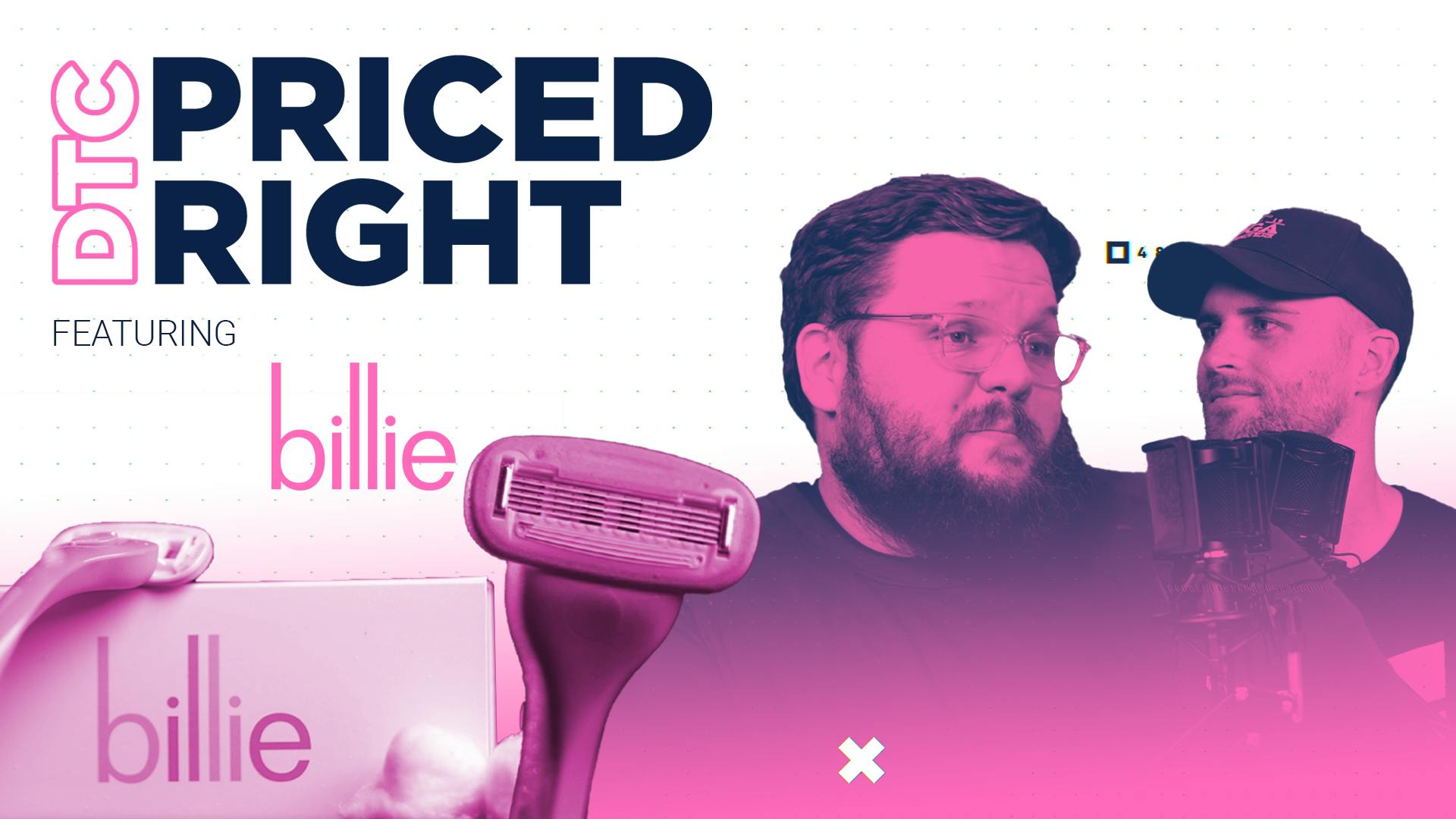
B-Side: The rise of passive, anti-active usage products
This episode might reference ProfitWell and ProfitWell Recur, which following the acquisition by Paddle is now Paddle Studios. Some information may be out of date.
Please message us at studios@paddle.com if you have any questions or comments!
Antiactive Usage
For decades we've been talking about active usage in the context of retention. After all, if someone is using the product, then they must be happy, right? Our market has changed though as we're able to measure outcomes better and automate more than we ever have before.
The result—our fixation on active usage may no longer be valid.
In fact, the data actually suggests that the least used products have the best retention, as long as they have a measurable outcome. I get that's a bit counterintuitive, so let's explore this concept with a nice framework, some examples, and of course the data to determine if you should be building a product for usage at all.
First though, what is a product supposed to do?
You may think this is an obvious question, but it's fruitful to ask, because we want to get deeper into the first principles of why your product exists. No matter your industry, your customer, or technology, the product you create ultimately provides some sort of outcome for your user.
We have many frameworks and catchy phrases for this phenomenon - jobs to be done, level up your customer, value plus outcome - but it's all the same concept. Your product + your customer = an outcome your customer seeks.
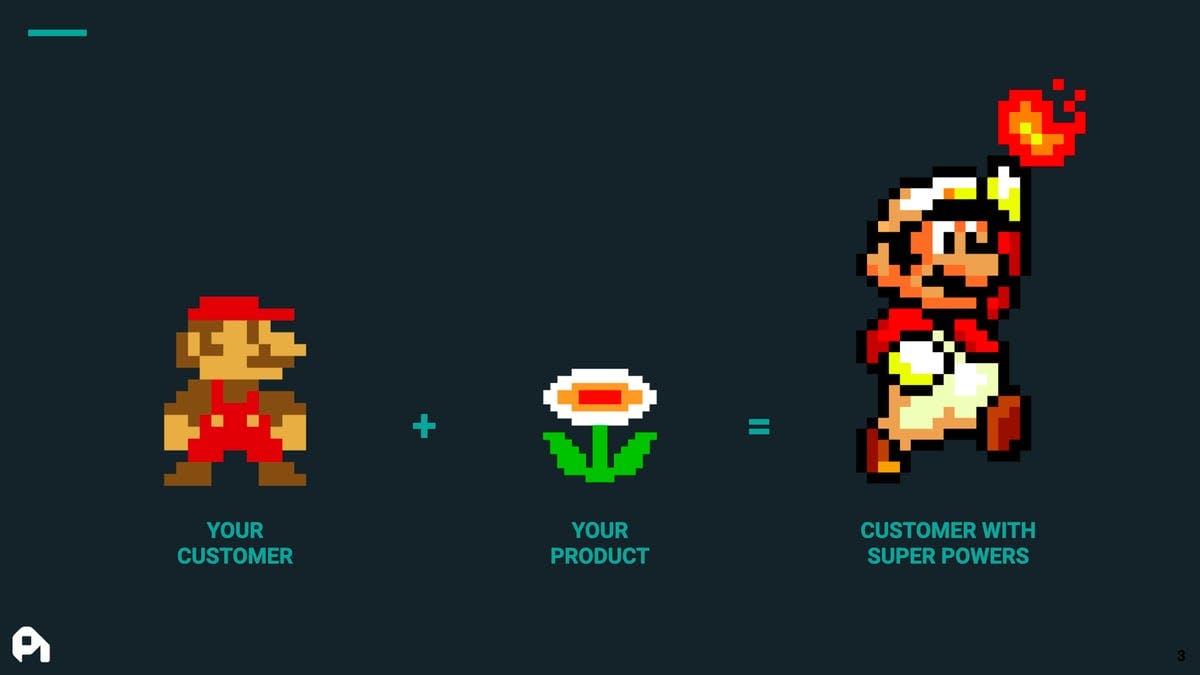
How do you measure that? Well, with a lot of products the outcome is tricky to measure. How do you measure joy for a game you're selling? If you don't have access to revenue data, how will you know the impact of your B2B app? Since we can't measure, we fall back to a proxy of active usage. Presumably active usage in Salesforce means you're making sales, right? Playing a game daily means you're getting joy, right? Basically, if they're using it, it must be valuable.
For a long time this was true, especially in the primitive SaaS 1.0 days where even measuring usage was hard. Expectations were different though. In a world where technology was difficult to build every product was magical. The alternative to salesforce was a spreadsheet or some old perpetual license software that got updated once every 18 months. Salesforce was updated almost weekly and gave you pretty graphs. In this world, the job of software and products was to show your boss you're doing work. If you're doing work, then an outcome should come, right?
Here's the problem though, a proper outcome isn't guaranteed with usage and that usage may just end up making the path to outcome onerous and long.
Continuing our Salesforce example, the main user is typically a sales rep of some kind who ends up needing to input endless fields of information to prove to the sales manager that progress is being made. The manager may be happy, but they're always chasing the sales reps to input the proper data under the right timeline. This data has no direct connection to getting a sale. It's merely tracking, which helps in the aggregate, but doesn't do much for the rep. It actually adds a tax to the work and the entire industries popped up around trying to make inputting data into Salesforce easier.
We were ok with these types of product until we weren't, especially when technology gave us the ability to not build these types of products. We've moved from an age of "show your work" to "just do the work for me."
Let's call this SaaS 2.0. These days you can't just throw a WYSIWYG editor and some forms on top of a database and call yourself a great product. Users are picky, because they have a lot of options. You can measure outcomes more easily and cheaply. You can even charge based on them (see value and pricing metrics content we've written). The result—we've changed "getting your customer to the outcome they seek" to "getting your customer to the outcome they seek as quickly and efficiently as possible."
Our response has been to fixate on the concept of "time to value"—getting your user to see the value in your product as quickly as possible. We've improved things like on-boarding, support, etc. Yet, I think we should be asking a more important question:
What if we just removed the usage? Why optimize for usage if we can give the customer value?
Let's go deeper here into a new framework for thinking through product in modern times.
Active usage or passive usage. Not the middle.
As to not bury the lede, I'm positing that we're heading into a world where your product needs to be daily usage by design—meaning you're a workflow tool. Or it needs to require no active usage to get value—meaning it's a passive tool. If you're somewhere in the middle, you will not succeed without going upmarket.
The reasoning here is that this comes down to baking retention into your product. If someone is using your product on a daily basis, your product is crucial to the work they're doing or they've been told they have to use your product. If the former, then you don't lose the customer unless some fancy new product comes along, but the customer will think twice because they have to disrupt their whole workflow. If the latter, then your end user isn't the real user you have to worry about, but if the end user keeps complaining about your product, you may be at risk.
Similarly, if your product ends up being passive and providing value, then there's no reason to cancel your product, because it's not causing undue burden on the user. We can model this phenomenon as the following.
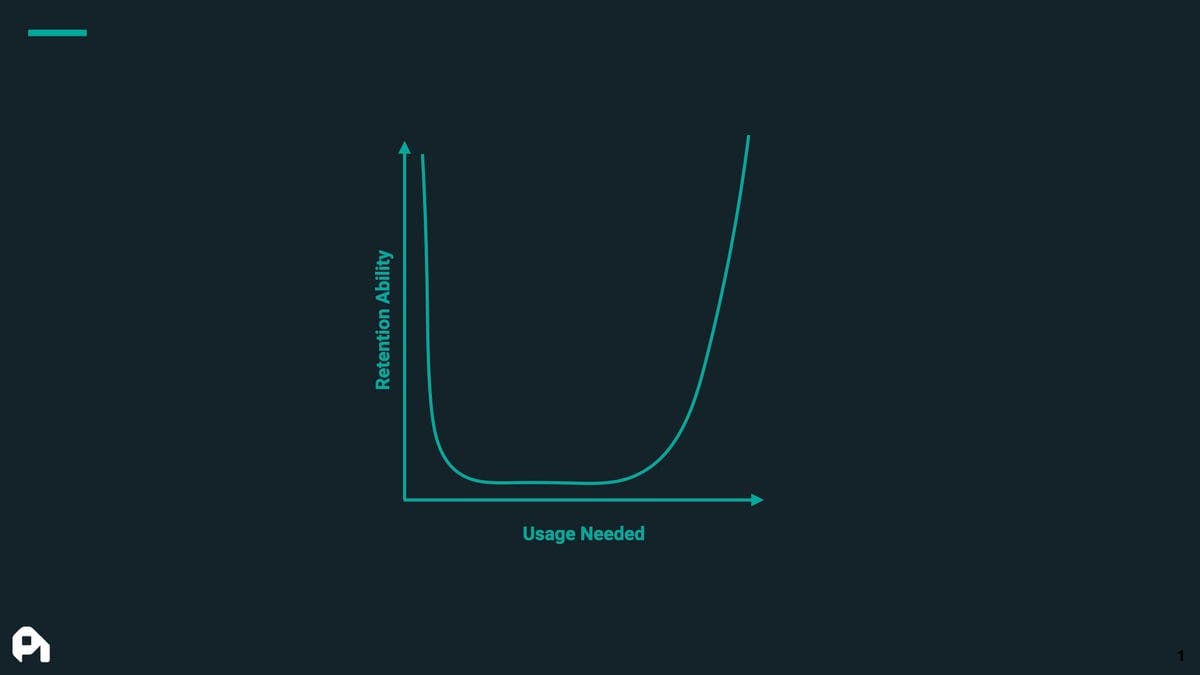
Remember this comes down to measurement too though, and products won't perfectly fall into one end or the other. So what's the framework we should use as a business? In my mind you have two key questions:
- How measurable is your outcome and how much does your customer agree with your measurement?
- How much can you truly automate?
Our first question around measurement is important, because if you're building passive products, measurement will likely be the only value driver for you. Inevitably your customer will evaluate if they should still pay for your product they aren't using, and if they can't see the success they won't keep paying you. Measurement isn't as important in daily-usage products, but will increase in importance with more competition. Our second question is crucial simply because we don't want to do needless work anymore, and I'll show some data on this soon.
We can represent our two questions on a nice, classic 2x2 with outcome measurability on the X axis and automation on the Y axis. I've plotted some different products to show you how they fall into our framework.
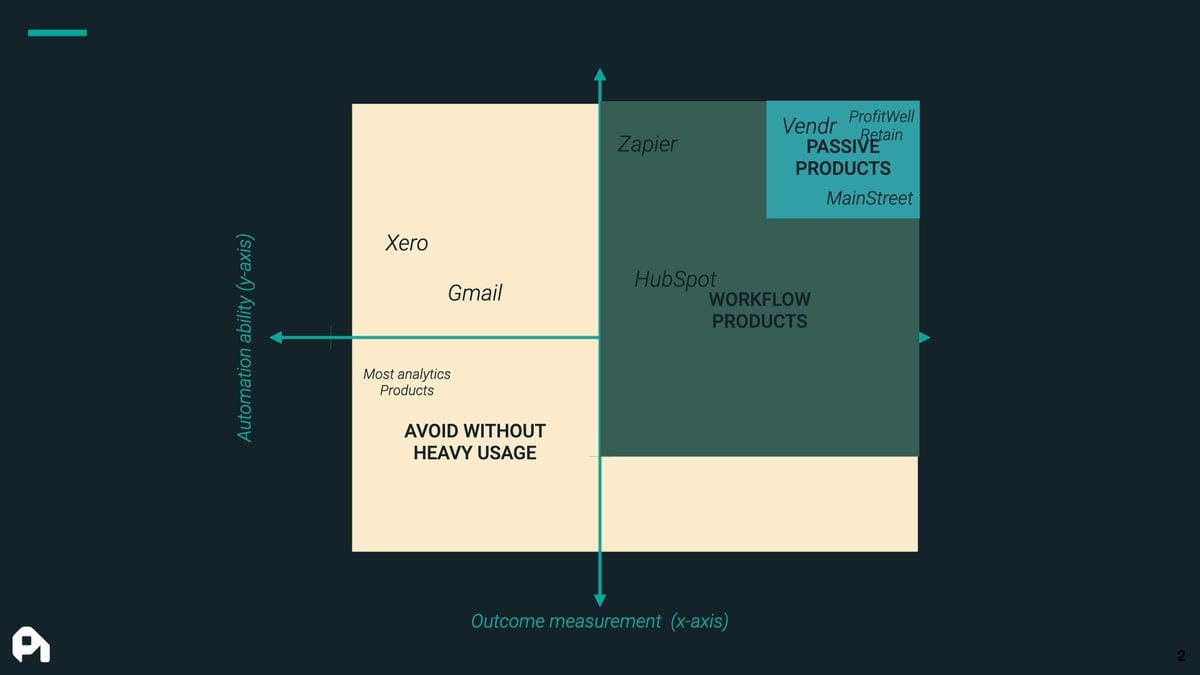
Within this model we have three main groups:
- High outcome measurability, High automation—passive products
This group is new and provides value with no work on your part apart from initial implementation. These products tend to succeed mainly because they're incredibly easy to verify as ROI positive. Short sales cycles and great retention.
A good example here is ProfitWell Retain—our churn reduction software—you plug it into your billing system, install a snippet, and make money. That's it. We're also able to measure a baseline of before Retain and performance with Retain, charging on this measurement to perfectly align with the customer. - Medium outcome measurability, Medium automation—workflow products
This group needs heavy usage for retention and oftentimes involves mission critical products.
HubSpot is a good example of this group, particularly their marketing product. HubSpot can't perfectly measure outcome, because even if they get revenue data into HubSpot (which you can do using ProfitWell's free HubSpot integration - hint hint :)), your customer may not agree to the measurement because they wrote the blog post or sent the email. How much credit should they get versus HubSpot? The ROI validation still takes place so they do need to get the data in there, but it won't be as elegant as a passive product. - Low outcome measurability, Low automation—avoid these products
These products tend to be useful, but not obviously useful, so they require heavy sales or "training of the market." I would avoid them unless you can raise a lot of money and go upmarket.
A great example is the analytics and business intelligence world. Most companies start out with the premise of, "well you need analytics to get insights and make decisions, so let's build a BI tool." What happens is they just create a tool with a bunch of graphs that the customer then needs to do the work to actually get the value. All that work creates a weird value differential, which is why most analytics tools have to go upmarket to serve a sophisticated buyer. Even then they still have terrible retention. As a side note, this is why ProfitWell metrics is free.
Ok, but what about the data?
Enough theory talk though, what's the data actually say about these products? Well, let's jam. Below you're looking at a breakdown of net revenue retention based on the strategy employed. The percentages are the lift or gain in retention relative to the overall median. Basically you're seeing how these strategies correlate with retention performance.
A couple of notes:
- Notice how products with high outcome measurement and no active usage have the greatest lift. These are products like Vend, MainStreet, and ProfitWell Retain.
- Products that require active usage, but have medium outcome measurement still get pretty good lift. These would be products like Salesforce, a bit of HubSpot, etc.
- Products without outcome measurement, but high active usage still do pretty well, but this is more table stakes. These would be products like gmail, your productivity app, etc.
- Products without outcome measurement and/or active usage see the biggest relative drop. These would be products like the analytics market (ironically).
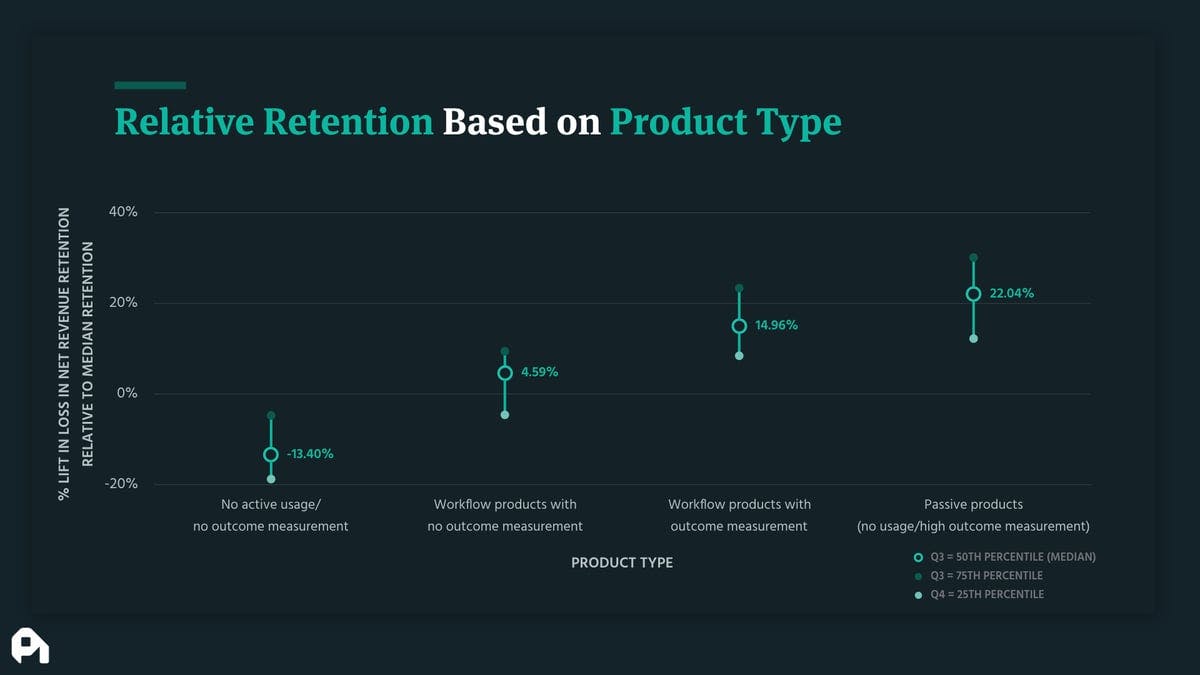
What should you do for your business?
Ideally, you'd pick a side. Be a passive tool that has near perfect outcome measurement or be a workflow tool that still has outcome measurement, but focuses heavily on active usage. In reality, a lot of products tend to have elements of both, so in short:
- Put measurable outcome into your product as much as possible
If your product drives revenue or saves cost, pull that data into your reporting. If you can't easily get the data, then do estimates. HubSpot does a really good job with this when it comes to SEO estimations by pulling in cost-per-click data and estimating how much the traffic would have costed with ads versus content.
If the point of your product isn't revenue or costs, then show some measure of value—a proxy for the outcome you're helping with through your product. A lot of productivity tools will show how much time they've saved or used the product, an indication of getting value.
- Focus on active usage only if it's in a workflow
Active usage for active usage's sake isn't going to scale if a competitor can easily remove a step on the side of the customer. Remember, we don't want to just show our work anymore. We want to just have the work done for us. Some products are still going to need usage from your customer, but just re-evaluate every step with, "can we automate or eliminate this step?" You'll be surprised at the amount of work you can reduce.
Do us a favor?
Part of the way we measure success is by seeing if our content is shareable. If you got value from this episode and write up, we'd appreciate a share on Twitter or LinkedIn.
00;00;00;01 - 00;00;04;29
Patrick Campbell
We continue to build a product based on advice that is 30 years old.
00;00;06;15 - 00;00;26;06
Ben Hillman
From proper well recur it, protect the hustle where we explore the truth behind the strategy and tactics of B2B SaaS growth to make you an outstanding operator. On today's episode, where diving deep on the rise of passive and active usage products. Patrick Take it away.
00;00;26;17 - 00;00;48;12
Patrick Campbell
Welcome back, everybody, to another episode of Protect the Hustle, where each week you get two episodes, One episode is a deep dive from another founder or executive. That's out there, and the other episode is a deep dive from me on some data or some sort of kind of concept or framework that I am working through. Basically kind of learning in public here, given all the data that we have.
00;00;48;12 - 00;01;08;06
Patrick Campbell
And if you're heading for this for the first time, I'm Patrick Campbell from CEO and founder of Profit. Well, and let's jump into some housekeeping here. So a couple of housekeeping items. We just launched another season of Boxed out. This is our show on retention in the subscription e-commerce market. So what we do is we actually go out and buy products and then basically test their retention tactics.
00;01;08;06 - 00;01;28;01
Patrick Campbell
So we buy those products, we look at their whole flows, we go and try to cancel, see what they do with email as well as their actual workflow. Basically, it's a data driven case study on a bunch of different companies, and so you can sign up for that or check out those episodes of Fool.com slash recur. Another housekeeping item we are hiring across the board.
00;01;28;14 - 00;01;43;08
Patrick Campbell
Don't think about it, just apply. That's what I've been telling people, which probably not the greatest thing I tell them. But if you're looking for a gig, you know someone is looking for a gig, even if you're kind of like, Oh, I don't know if I'm looking, but like, maybe we should talk. You know, Patrick's kind of interesting or profile's kind of interesting.
00;01;43;08 - 00;02;00;23
Patrick Campbell
Doesn't have to be about me. But yeah, if any of those things, feel free to basically reply to the email that you get or reach out to me on any social media platform, I would love to chat with you or that person and I'm going to make it a great experience for you or them. Doesn't have to be anything too onerous or something that they don't enjoy.
00;02;01;01 - 00;02;21;15
Patrick Campbell
And I'm also happy to give referral bonuses if we end up hiring anybody from this, which I hope we do since we need lots of people. And also another thing here, I've been having dozens of conversations the past couple of weeks. Not a typo. A lot of people who are struggling with COVID right now and you know, they also feel bad for struggling with COVID because there's kind of a light at the end of the tunnel.
00;02;21;15 - 00;02;38;13
Patrick Campbell
I think that's ironically what's causing them to also feel bad is that there's this light at the end of the tunnel. If you're in this boat, know you're not alone. A lot of people that have been talking to you, they basically are acting like it's a secret. And I think that's what's causing us to all kind of struggle actually individually, even though we're all struggling together.
00;02;38;13 - 00;02;55;29
Patrick Campbell
So just make sure you're talking to someone doesn't have to be someone who's a professional therapist or something like that. I talked to a friend, talked to a colleague, talked to a loved one, just someone to make sure that you're getting those emotions out. You're getting those thoughts out because I think you're going to discover that there's a lot of people who are struggling right now, especially now that we're a year plus into this.
00;02;56;07 - 00;03;17;07
Patrick Campbell
But with that last little housekeeping item, make sure you're signed up. We're going to be talking through some data as well as we're going to be talking through some frameworks that I've actually kind of drawn out. Obviously, I can't get those across in audio form, so feel free to go to protect the hustle dot com. You'll see the whole post, but you can also sign up to get the audio version as well as the email version right into your inbox.
00;03;17;07 - 00;03;34;13
Patrick Campbell
You don't even have to leave the email if you don't want to, but just go to protect our cellcom and make sure you signed up. Okay, so let's jump in. We're going to be talking about active usage today and this whole concept of why active usage just may not be the thing that we should fixate on as much when it comes to retention.
00;03;34;26 - 00;03;53;16
Patrick Campbell
And the reason I wanted to talk about this is because for decades we have been talking about active usage in the context of retention. And the basic idea is, you know, of course, if someone is using your product, they must be happy, right? Well, the problem is that our market has changed incredibly a lot. It's a weird way to say it, but our market has changed considerably.
00;03;54;00 - 00;04;19;17
Patrick Campbell
And because of that, we're now able to measure outcomes better and automate more than we ever have before. And so the result of this is that our fixation on active usage may no longer be valid, because when we think through the first principles of what active usage is about, we'll talk about in a second. It's really about going for that outcome and if we can measure the outcome and also automate it so that the user doesn't have to use the product, then why are we fixated on active usage?
00;04;19;27 - 00;04;35;23
Patrick Campbell
And also just to kind of not bury the lead a little bit, but also kind of bury the lead a little bit? The data actually suggests that the least used products tend to have the best retention, and I'm not talking about the least used products in the sense of, oh, they forgot about the product and it's just being charged in their credit card.
00;04;36;00 - 00;04;57;22
Patrick Campbell
No, just the least use proper products tend to have the best retention and so maybe we should focus on not necessarily usage. So I guess that's a bit counterintuitive. So we're going to explore this with a nice framework, of course, some examples and always some data to determine basically if you should stop building a product for usage at all, which probably isn't going to be that outlandish, but we'll see what happens here.
00;04;57;22 - 00;05;17;10
Patrick Campbell
So first, what is a product supposed to do? So I know this seems like an obvious question, but it's really fruitful to ask because we want to get deeper into the first principles of why your product exists. And no matter your industry, your customer, your technology, the product you create, it's ultimately there to provide some sort of outcome for your user.
00;05;17;12 - 00;05;37;07
Patrick Campbell
So we have a lot of frameworks for this, lots of catchy phrases, jobs to be done, level up your customer value plus outcome. But it really all comes down to this Your product plus your customer equals some sort of outcome that your customer was seeking. So how do we measure that? Well, a lot of products, the outcome is actually really tricky to measure.
00;05;37;07 - 00;05;55;16
Patrick Campbell
So how do you measure the joy that someone is receiving from a game or the laughter that they're receiving from some sort of content product? Or if you don't have access to revenue data, how are you going to measure the impact of that B2B app that you have? And so since we can't measure it, we tend to fall back on different proxies.
00;05;55;23 - 00;06;14;28
Patrick Campbell
Now, some of these proxies are the number of contacts in account, the number of users in an account. But a lot of times it does fall back to this active usage concept that's been around for decades at this point and presumably active usage inside Salesforce, for example, means you're making sales, right? Or playing a game daily means you're getting value or joy out of it.
00;06;14;28 - 00;06;33;20
Patrick Campbell
Correct. Basically that comes back to this concept that we've already talked about a little bit, which is that if you're using it, it must be valuable. And if we take a step back and we really look at the history of our industry, for a long time this was totally true, especially in kind of the primitive SAS 1.0 days where, you know, even measuring usage was really, really difficult.
00;06;34;00 - 00;06;54;02
Patrick Campbell
Expectations were really, really different, too. In a world where technology was difficult to build, every product was magical. You could slap a, you know, log in screen on a database and you were a god. And the alternative to something like Salesforce was a spreadsheet or some old perpetual license software that, you know, maybe got updated or more features like once every 18 months.
00;06;54;02 - 00;07;16;27
Patrick Campbell
When you bought the new version, Salesforce was updating weekly with new features or new functionality. And ultimately it was one of those things where Salesforce was able to basically, you know, convince you that kind of logging in and giving you these pretty graphs that would get updated was really, really valuable because it was. And in this world, the job of software and products was to show your boss you're doing work.
00;07;16;27 - 00;07;40;02
Patrick Campbell
If you're doing work, that an outcome should come right? And it was basically because these were the first kind of like infrastructure type products for work. And so that meant you had to show your boss doing work because a lot of the work of the past, you know, kind of century was, hey, I need a boss that like sits over my shoulder and makes sure that I'm you know, a little worker, B, you know, kind of like in the panopticon, you know, type concept.
00;07;40;18 - 00;08;12;17
Patrick Campbell
So here's the problem, though. A proper outcome was never guaranteed with usage. And that usage may just end up being something that makes the path to an outcome onerous and way too long. So if we continue our Salesforce example, the main users, typically a sales rep of some kind who ends up needing to input endless fields of information to prove to the sales manager that the progress is being made, the manager may end up being happy, but they're always chasing that sales rep to input the proper data under the right timeline.
00;08;13;00 - 00;08;30;00
Patrick Campbell
So the data has no direct connection to getting a sale. It's merely tracking, which yes, does help in aggregate, especially if you have a very, very large sales team. But it doesn't do much for the wrap. It doesn't actually help with the outcome necessarily of getting more sales. It helps the sales manager kind of manage a team by the numbers.
00;08;30;13 - 00;08;54;19
Patrick Campbell
It actually adds tax to the work of getting that sale. And because of this, there's an entire industry that's popped up around trying to make inputting data into Salesforce easier. And Salesforce has kind of punted and said, Hey, our marketplace is what you can essentially use to fix some of these UX issues, essentially. And we were okay with these products basically until we weren't, especially when technology gave us the ability to not just build these types of products.
00;08;54;19 - 00;09;14;26
Patrick Campbell
We've moved from a world where it's very show your work to, Hey, just do the work for me and let's call this age, you know, Sast 2.0 these days you can't just throw a whizzy wig editor or what you see is what you get. Ed and some forms on that database and call yourself a great product. Users are much, much pickier because they have a lot of options.
00;09;14;26 - 00;09;39;00
Patrick Campbell
We've arrived as an industry where there are so many products out there and it's easier and easier to build. Not easy, but easier and easier. We can also measure outcomes more easily and cheaply and we can even charge based on them, you know, see value in pricing metrics, topics that I've written about. I always talk about you want to charge as close to value as you can, and there's a lot of tooling, especially the billing systems out there, that now allow you to do this.
00;09;39;00 - 00;10;00;18
Patrick Campbell
And the result is we have changed getting your customer to the outcome they seek. Remember that whole concept to getting your customer to the outcome they seek as quickly and efficiently as possible. And our response as a product world has been to fixate on the concept of time to value, which is giving that user to see the value in your product as quickly as possible.
00;10;00;29 - 00;10;28;26
Patrick Campbell
And that means we've improved things like onboarding support to all of these other pieces around those two concepts. And I think we're missing and we should be asking an even more important question, which is the entire premise of this episode, which is what if we just removed the usage? Why are we optimizing for usage If we can give the customer value without usage, and this is where we're going to go a little bit deeper after kind of, you know, setting things up here because again, we're in modern times here.
00;10;28;26 - 00;10;51;15
Patrick Campbell
So let's talk about active usage or passive usage. And basically the thesis is and I don't want to bury the lead, is that basically I believe we're heading into a world where your product needs to be daily usage by design, meaning you are a workflow tool, there's no other way around it, or it needs to require no active usage to get value, meaning it's a passive tool.
00;10;51;15 - 00;11;06;13
Patrick Campbell
And if you're going to be somewhere in the middle, I think that you will not succeed. You will not succeed unless maybe you raise a good amount of money and go upmarket, which is what a lot of folks who sit in the middle have basically done. And the reasoning here is that this comes down to baking retention into your product.
00;11;06;24 - 00;11;25;13
Patrick Campbell
If someone is using your product in a daily basis, your product is probably crucial to the work that they're doing or they're being told that they need to use your product. Now, if it's the former, then you're not going to lose the customer unless some fancy new product comes along. But the customer will definitely think twice because they have to disrupt their entire workflow.
00;11;25;27 - 00;11;51;15
Patrick Campbell
Now, if it's the latter, then your end user isn't the real user. You have to worry about. But if the end user keeps complaining about your product, you may end up being at risk. So it gets a little bit more complicated. Now, similarly, if your product ends up being passive, but also provides value, which is a really, really important distinction and there's no reason to cancel your product because it's not causing undue burden on the user, it's simply providing that value.
00;11;51;15 - 00;12;11;05
Patrick Campbell
And we can model this phenomenon in kind of just a a really basic, you know, kind of graph. And imagine there's a big you kind of line on the graph. So on the y axis, we're basically looking at, you know, retention potential. And then on the x axis, the horizontal axis, we're looking at how much usage is required for the product and it's a big use.
00;12;11;05 - 00;12;31;06
Patrick Campbell
So basically on the left, you know, it doesn't require a lot of work. It's a passive product, but, you know, basically has really, really high retention potential and then all of a sudden that goes down. We're meaning if it requires some usage but not a lot of usage, it's probably not going to have good retention potential. And then on the far right, you're looking at really high usage, really high revenue retention potential.
00;12;31;06 - 00;12;55;11
Patrick Campbell
You can get the graphs that protect the hustle dot com. Now remember, this comes down to measurement in a lot of the case here and products won't perfectly fall into one end or the other. So what's the framework that we should think of as a business Now in my mind you have two key questions. The first question is how measurable is your outcome and how much does your customer agree with your measurement, which is really, really important.
00;12;55;11 - 00;13;19;00
Patrick Campbell
If they don't agree with the measurement, it's going to be difficult to charge along this or actually have an outcome for that passive type product. And then the second question here is how much can you truly automate? Now, in our first question around measurement, it's really important because if you're building some sort of passive product, measurement will likely be the only value driver for you because you're not training the user to use the product everyday.
00;13;19;00 - 00;13;38;21
Patrick Campbell
They're not being told or have to use the product every day. So there needs to be some sort of verifiable or validating thing that they can look at in order to see like, yes, I am getting value because inevitably your customer is going to evaluate if they should still be paying for your product that they aren't using, and if they can't see the success, they won't keep paying you.
00;13;38;21 - 00;13;55;22
Patrick Campbell
Now, measurement isn't as important in daily usage products, but it will increase in importance with more competition. If I'm looking at my HubSpot account, which you know, I do have to use to get the value out of and I'm noticing that I don't really feel I'm getting the value because they're not reminding me of how much value they're providing me.
00;13;55;29 - 00;14;14;11
Patrick Campbell
Well, maybe I want to move on to another marketing automation product. Now, our second question here around how much can you truly automate is crucial simply because we don't want to need this work someone and because of that, we need to make sure that we're moving towards this world that we're now in. Hey, just do the work for me.
00;14;14;12 - 00;14;31;04
Patrick Campbell
Now. We can represent these two questions on a nice kind of classic two by two. Shout out to all the MBAs who are listening. We love your two by twos. I know, but we can look at this on a classic two by two with outcome measure ability on the x axis, meaning the horizontal axis, and then automation on the Y axis.
00;14;31;16 - 00;14;56;09
Patrick Campbell
And you can get this at protect the hustle. Com But I've plotted, you know, some different products and companies along these actions to show you how they kind of fall into the framework And there's really three main groups that you can see and I've kind of documented in this post where essentially you have a group that's kind of in the upper square, meaning not just in the whole, you know, upper right square, but kind of in the upper right part of the entire graph.
00;14;56;25 - 00;15;20;29
Patrick Campbell
And these are the folks that are basically high outcome measurability and high automation. These are passive products. Now, this group is new. It's very new because people have not really thought of building products that don't have active usage until, you know, quite recently, the past 5 to 10 years and you get the entire value of the product with no work on your part except for initial implementation.
00;15;21;14 - 00;15;38;24
Patrick Campbell
These products tend to be successful mainly because they're incredibly easy to verify as ROI positive. They have shorter sales cycles and they have really, really great retention as we'll see in the data and the second products that fall into this category. There's a product called Main Street. Basically you plug it in and it finds you tax credits for your business.
00;15;39;07 - 00;15;59;28
Patrick Campbell
There's products like Vender, which is basically a product that you plug in and automatically reduces the cost of software. They go and, you know, negotiate all your contracts. So they have big agreements with different companies in order to negotiate contracts. But then another good selfish examples, Praful Retain, which is our churn reduction product. You basically plug it into your billing system, you install a snippet and we make you money.
00;16;00;03 - 00;16;21;13
Patrick Campbell
That's it. We're also able to kind of measure the baseline before and after, retain and basically charge based on that difference, which is what a lot of these products end up doing. Now the next kind of squared down, which is kind of where the most products kind of fall is medium outcome measurability and medium automation. These are the workflow products that we've talked about.
00;16;21;26 - 00;16;40;25
Patrick Campbell
This group needs heavy usage for retention and oftentimes involves mission critical products, meaning if you're not in kind of, hey, this org has to use your product and they can't imagine running their org without your product, you're going to have a really, really difficult time. And HubSpot already kind of referenced is a really good example of this group, particularly their marketing product.
00;16;40;27 - 00;17;01;03
Patrick Campbell
HubSpot can't perfectly measure the outcome because even if they get revenue data into HubSpot, which you can do for free using Parafoil metrics and our HubSpot integration, which is free, just a little hint hint there. But even if you can get revenue data into HubSpot, your customer may not agree to the measurement because they wrote the blog post or sent the email.
00;17;01;03 - 00;17;20;18
Patrick Campbell
So if I send the email or at the blog post and they make $100,000, well, how much should HubSpot have to do with that versus me? You know, I did the creativity, I wrote the post, but they definitely gave me the access, right? And it's really hard to square like what a percentage would look like. There and in there for you're asking the question like, how much credit should they get, you know, versus HubSpot.
00;17;20;18 - 00;17;41;00
Patrick Campbell
So the ROI validation still does take place. So they need to get the data in there, but it won't be as elegant as a passive product. Put another way, it's one of those things that keeps the hooks of a customer into HubSpot rather than kind of releasing and going to someone else. If you can remind them like, Oh, we're making a lot of money through the thing that we're doing with HubSpot.
00;17;41;14 - 00;18;08;20
Patrick Campbell
And then the final group here are the low outcome measurability, low automation products, and this is basically most of the left side of our to buy to these products. You know, they tend to be useful but not obviously useful and that's the problem. So they require heavy sales or training of the market and I would avoid these products at all costs unless you can raise money and definitely go up market and a really good example of these types of products are analytics and business intelligence tools.
00;18;09;04 - 00;18;25;17
Patrick Campbell
Most companies in this space, in analytics and business intelligence, they start off with the premise of, well, you need analytics because it gives you insights and then you make decisions based on that. So let's build this BI tool. It's going to be awesome. We're going to democratize these analytics across this space right? This is what everyone starts off with.
00;18;25;17 - 00;18;47;20
Patrick Campbell
Domo started off with this. Mixpanel, start off with this. We're going to democratize. Problem is, is that you create a tool that takes a bunch of data and puts it into a bunch of graphs. And I know that's kind of trivializing it. And there's definitely more value than that trivialization. But what ends up happening is the customer needs to do the work to actually get the value they need to pass through the data.
00;18;47;20 - 00;19;18;06
Patrick Campbell
They need to look through it. They feel like they're doing much more work than your graph did because they've created a chart in Excel or in PowerPoint or Keynote. Therefore they know how hard it is to create that tool. And it shouldn't be that hard, right? When I'm being facetious and sarcastic by design here. But the thing is, is it creates a weird value differential and this is why most analytics tools, they end up having to go up market to survey sophisticated buyer or someone who has just a buy requirement.
00;19;18;07 - 00;19;38;16
Patrick Campbell
You know, the CEO comes from a board meeting and goes, We need to invest in business intelligence, and then they allocate $500,000, you know, a couple hundred grand and engineers. I mean, basically that's what, you know, ends up being there buy tool and then everyone still complains about it, but they still use it right. And so they tend to have really bad retention unless they go up market.
00;19;38;16 - 00;19;57;12
Patrick Campbell
And as a side note, this is why we ended up giving profit metrics away for free is because we saw this really early on in doing our market research. And based on that research we just decided, hey, we're either need to give up on this product, which was an also a option, or we need to basically take this product and, you know, give it away for free or go up market.
00;19;57;13 - 00;20;12;02
Patrick Campbell
And we kind of chose the free route. But all that being said, let's talk through some data. As you know, enough talk, you know, through theory here. Let's get into the actual data here. And this is where I probably should have put this at the front of the post, but I wanted to kind of explain the background. But this is where a lot of this comes from.
00;20;12;02 - 00;20;41;19
Patrick Campbell
And what I wanted to do and what I did actually, I should say, is I broke down net revenue retention based on the strategy employed. So what you're seeing here, if you go to protect our selection, but also explain it is that basically we took the median retention of a group and then we had that group categorized by were they a high outcome measurement product where they had daily usage products, were they an anti daily usage product and then basically measured those buckets relative to the median.
00;20;41;19 - 00;21;00;03
Patrick Campbell
So you're seeing percentage lifters, percentage loss essentially in retention based on like the strategy and it's correlated of obviously, but it's one of those things I think is really, really interesting. And so basically you're seeing how these strategies correlate with retention performance. So I'll talk through a couple of these for the audio version here. So a couple of notes.
00;21;00;03 - 00;21;22;19
Patrick Campbell
So products with high outcome measurement and no active usage. So the profile over teens of the worlds, the mean streets, the vans tend to have the greatest lift on retention. So the lift is about 25% on a median basis. There's a bit of a range here, so you can kind of check that out. Products that require active usage but have high output measurement, meaning like the HubSpot.
00;21;22;19 - 00;21;45;11
Patrick Campbell
And it's the medium outcome measurement, you know, kind of based on what I told before. So it's not perfect, but it is something where they validate, still get a pretty good lift. It's about 15%. And then products without outcome measurement by high active usage. So these would be like Gmail, productivity apps, etc. They're actually pretty neutral. There's a little bit of a gain, but there's also the range kind of goes across the negative side as well.
00;21;45;22 - 00;22;09;24
Patrick Campbell
So it's one of those things where this is kind of like table stakes, basically, like you need to make sure if you don't have outcome measurement, you got to have active usage and don't think if you have, you know, high outcome measurement, but you know, heavy usage is necessarily going to change as much. But then the final one here is products without outcome measurement or active usage, which is, you know, the analytics products that I talked about, they tend to see the biggest drop drops by about 25%.
00;22;10;07 - 00;22;31;21
Patrick Campbell
And so it's just kind of fascinating. They'll look at this mainly because I think that if I'm looking at this as a business, I don't want to fight a losing battle. And what that means is, is that I want high outcome measurement as much as humanly possible that the customer agrees to and I want as little usage as possible, unless it's like absolutely mission critical to the product.
00;22;31;21 - 00;22;48;21
Patrick Campbell
And that's kind of a good summary of what I think you should do as a business. But to give a little bit color to this, I think you've got to pick a side, be a passive tool that has a near-perfect outcome measurement, or be a workflow tool that still has some outcome measurement, but focuses heavily on active usage of the right pieces.
00;22;48;21 - 00;23;08;15
Patrick Campbell
You know, in a reality, you're going to end up having both. But, you know, we talk a lot about the category creation in these types of things, but I think the essence of your product is infinitely more important, especially when it comes to user. So the first point here to kind of talk through a little bit, we belabored it a little bit, but I think it's worth kind of recapping, put measurable outcome into your product as much as possible.
00;23;08;18 - 00;23;23;16
Patrick Campbell
If your product drives revenue or saves costs, pull that data into your reporting. You can use a tool like profit. Well, basically meaning like you can build an integration to profit well, and we're happy to help where literally it just pulls that data into your product. It's one of those things that, you know, we've offered to a lot of people.
00;23;23;16 - 00;23;40;02
Patrick Campbell
We started building a lot of integrations because their customers can now verify that the product is actually valuable, especially if they're trying to drive some sort of outcome. Now, if you can't easily get this data or this data, it's not perfect that doing estimates is fine. I think HubSpot does a really good job with this when it comes to kind of estimations.
00;23;40;02 - 00;23;55;00
Patrick Campbell
So they pull in kind of cost per click data and basically estimate like, okay, so if this traffic, if you ended up having to pay for it with ads, this is how much it would cost, but you didn't have to pay that. So that's great, right? So they're not charging based on that, but they're basically saying like, hey, there's value here.
00;23;55;11 - 00;24;16;20
Patrick Campbell
Now, if their point of your product isn't revenue or cost, then you can show some sort of measure of value. So a proxy for the outcome you're helping them with. So if you're a productivity tool, you know, show them how much time they've used the product or they presumably have saved by using your product, it's an indication of value and you're probably not going to charge along it, but at least you're going to be able to kind of reinforce that your product is valuable.
00;24;17;03 - 00;24;33;23
Patrick Campbell
Now, the second big thing here is, you know, focus on active usage only if it's in a workflow. So we talked about this a bit, but active usage for active users sake just isn't going to scale. If a competitor can easily come in and basically sidestep you with the customer, you got to remember like, we don't want to show our work anymore.
00;24;33;23 - 00;24;49;15
Patrick Campbell
We just want the work to be done, especially if it's not work that's focused on the product or focus on the customer. This is why Retain has been successful because we're like, Hey, you could build this. You probably can't at this point because there's so much functionality built into it and the data set you're just not going to have.
00;24;49;26 - 00;25;04;10
Patrick Campbell
But you could build something that helps a little bit with this, but you're never going to you're never going to become an expert in this, etc., etc.. And therefore, like you can just use a product. And most of the time people say, yeah, of course they're not even bringing up the objection. So we want to have that work done for us.
00;25;04;10 - 00;25;18;19
Patrick Campbell
And some products are still going to need some usage. And even with, you know, our metrics, right, we do measure usage and we have really great usage, but it's not something where every single person has to use the product every single day. And so we don't want to fixate on that. We don't want to counter chickens based on that.
00;25;19;01 - 00;25;42;12
Patrick Campbell
And so when you have some of these products are still are going to need usage, you know, reevaluate every step you have with can we automate or eliminate this step and you will be surprised at the amount of work you can reduce proof profit. Well, we argue not necessarily volatility, but we definitely heavily discuss when we are going to put a busy week editor into the app.
00;25;42;15 - 00;25;57;02
Patrick Campbell
I actually don't think we have any with you. What you see is what you get editors in the app. We definitely argue whether we've had the argument about like, how do we make it better for the user? How can we do it? Can we add a human like our humans? Can we add our humans to do it for them?
00;25;57;12 - 00;26;13;00
Patrick Campbell
Like, why would we even want to like making them do the work? And some of those things, like some of our users are like, Well, just let me do it. Like, I just want to do it. But it's like, No, no, no, we are going to do it for you to be seamless. But also there's, you know, there's an element of like, you know, we know better when it comes to some of these things.
00;26;13;00 - 00;26;29;17
Patrick Campbell
You know, we know the best, you know, type of automation to do. We know the best type of experiments to do in these types of things. So I think having those healthy arguments inside a product team is actually super, super beneficial and that's what you should be optimizing for rather than not. Okay, well, let me know what you think.
00;26;29;17 - 00;26;48;08
Patrick Campbell
Let me know some feedback. This is a I don't know if it's quite half formed, but it's definitely not a set in stone concept. There's some other axes that we didn't address that I think are worthwhile to kind of think on and go deeper on. And so, yeah, let me know the feedback. Let me know your thoughts and then ultimately, you know, make sure you're signed up and protect the hustle dot com.
00;26;48;19 - 00;27;03;28
Patrick Campbell
And if you found value in this, would love you to share it will love it. Tell your friends about it. Your colleagues about it. We're trying to make this community grow and we're trying to make this community have as much value as possible. And a lot of you are responding to the emails and giving me tons of feedback, which is there for improving things.
00;27;03;28 - 00;27;13;17
Patrick Campbell
So keep all of that coming because, you know, we're doing this for you. We're all learning together. So I appreciate you all. Have a great weekend. And we'll talk next week. We'll see you.
00;27;17;08 - 00;29;28;02
Ben Hillman
Thanks for listening. If you enjoyed this episode, we'd really appreciate it if you left a five star review of this podcast or the equivalent rating wherever you listen or watch. Also, make sure you subscribe to and tell your friends about Protect the Hustle, a podcast from Al Roker, the largest, fastest growing media network dedicated to the world of subscriptions.

